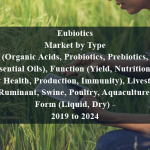OVERVIEW
The global market for food certification is projected to hit USD 12.65 billion by 2025, rising at a CAGR of 4.8% from 2020. The industry’s future primary markets are developing economies such as India, China and Brazil. Increasing foreign trade has fuelled demand for food certifications, combined with raising food safety regulations. Rising foodborne disease prevalence is expected to drive market growth during the review period.








TABLE OF CONTENT
1 Global Food Certification Market
1.1 Study Objectives
1.2 Market Definition
1.3 Study Scope
1.3.1 Markets Covered
1.3.2 Geographic Scope
2 RESEARCH METHODOLOGY
2.1 Research Data
2.1.1 Secondary Data
2.1.1.1 Key Data From Secondary Sources
2.1.2 Primary Data
2.1.2.1 Key Data From Primary Sources
2.1.2.2 Key Industry Insights
2.1.2.3 Breakdown of Primaries
2.2 Market Size Estimation
2.2.1 Bottom-Up Approach
2.2.2 Top-Down Approach
2.3 Market Breakdown and Data Triangulation
2.4 Research Assumptions
3 Global Food Certification Market – Executive Summary
3.1 Market Revenue, Market Size and Key Trends by Company
3.2 Key Trends by type of Application
3.3 Key Trends segmented by Geography
4 Global Food Certification Market – Comparative Analysis
4.1 Product Benchmarking – Top 10 companies
4.2 Top 5 Financials Analysis
4.3 Market Value split by Top 10 companies
4.4 Patent Analysis – Top 10 companies
4.5 Pricing Analysis
5 Global Food Certification Market – Industry Market Entry Scenario
5.1 Regulatory Framework Overview
5.2 New Business and Ease of Doing business index
5.3 Case studies of successful ventures
5.4 Customer Analysis – Top 10 companies
6 Global Food Certification Market – Market Forces
6.1 Introduction
6.2 Market Dynamics
6.2.1 Drivers
6.2.2 Opportunities
6.2.3 Challenges
6.3 Porters Analysis of Market
6.3.1 Bargaining power of suppliers
6.3.2 Bargaining powers of customers
6.3.3 Threat of new entrants
6.3.4 Rivalry among existing players
6.3.5 Threat of substitutes
7 Global Food Certification Market – Strategic Analysis
7.1 Value Chain analysis
7.2 Product Life Cycle
7.3 Supplier and distributor analysis (Market share and product dealing strategies)
8 Global Food Certification Market – By Type (Market Size – & million/billion)
8.1 ISO 22000
8.2 IFS
8.3 Halal
8.4 Kosher
8.5 BRC
8.6 SQF
8.7 Others
9 Global Food Certification Market – By Category
9.1 High-risk foods
9.2 Low-risk foods
10 Global Food Certification Market – By Application
10.1 Meat, poultry, and seafood products
10.2 Dairy products
10.3 Infant food
10.4 Beverages
10.5 Bakery & confectionery products
10.6 Free-from foods
10.7 Others
11 Global Food Certification Market – By Supply Chain
11.1 Growers
11.2 Manufacturers
11.3 Retailers
11.4 Others
12 Global Food Certification Market – By Geography (Market Size – & million/billion)
12.1 Introduction
12.2 North America
12.2.1 US
12.2.2 Canada
12.2.3 Mexico
12.3 Europe
12.3.1 U.K
12.3.2 Germany
12.3.3 Italy
12.3.4 France
12.3.5 Spain
12.3.6 Rest of Europe
12.4 Asia-Pacific
12.4.1 China
12.4.2 Japan
12.4.3 India
12.4.4 South Korea
12.4.5 Rest of APAC
12.5 Rest of the World
12.5.1 South America
12.5.2 Middle East
12.5.3 Africa
13 Global Food Certification Market – Entropy
13.1 New product launches
13.2 M&A’s, collaborations, JVs and partnerships
14 Global Food Certification Market Company Profile (Key Players)
14.1 Market Share, Company Revenue, Products, M&A, Developments
14.2 Dekra
14.3 Intertek
14.4 Tüv Süd
14.5 SGS
14.6 Lloyd’s Register
14.7 Asurequality
14.8 Kiwa Sverige
14.9 DNV
14.10 Bureau Veritas
14.11 Eurofins
14.12 Company 11 & more
15 Global Food Certification Market – Appendix
15.1 Sources
15.2 Abbreviations













